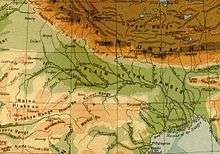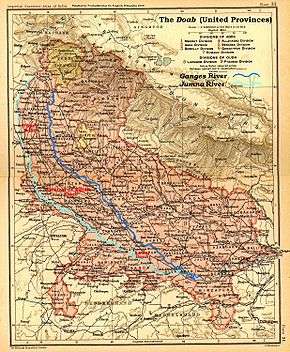Āryāvarta
Āryāvarta (Sanskrit: आर्यावर्त, lit. "abode of the Aryas" (noble or excellent ones),[web 1][web 2] Sanskrit pronunciation: [aːrjaːˈʋərtə]) was a term for northern parts of the Indian subcontinent in the ancient Hindu texts such as Dharmashastras and Sutras. The limits of Āryāvarta extended over time, as reflected in the various sources, as the influence of the Brahmanical ideology spread eastwards in post-Vedic times.[3][4]
.png)
Geographical boundaries
Ganges-Yamuna doab


The Baudhayana Dharmasutra (BDS) 1.1.2.10 (perhaps compiled in the 8th to 6th centuries BCE) declares that Āryāvarta is the land that lies west of Kālakavana, east of Adarsana, south of the Himalayas and north of the Vindhyas, but in BDS 1.1.2.11 Āryāvarta is confined to the doab of the Ganges-Yamuna. BDS 1.1.2.13-15 considers people from beyond this area as of mixed origin, and hence not worthy of emulation by the Aryans. Some sutras recommend expiatory acts for those who have crossed the boundaries of Aryavarta. Baudhayana Srautasutra recommends this for those who have crossed the boundaries of Aryavarta and ventured into far away places.[5]
The Vasistha Dharma Sutra (oldest sutras ca. 500–300 BCE) I.8-9 and 12-13 locates the Āryāvarta to the east of the disappearance of the Sarasvati River in the desert, to the west of the Kālakavana, to the north of the Pariyatra Mountains and the Vindhya Range and to the south of the Himalayas.[6]
Patanjali's Mahābhāṣya (mid 2nd century BCE) defines Āryāvarta like the Vasistha Dharmasutra. According to Bronkhost, he "situates it essentially in the Ganges plan, between the Thar desert in the west and the confluence of the rivers Ganges (Ganga) and Jumna (Yamuna) in the east."[3]
From sea to sea
The Manusmṛti (dated between 2nd cent. BCE to 3rd cent. CE) (2.22) gives the name to "the tract between the Himalaya and the Vindhya ranges, from the Eastern Sea (Bay of Bengal) to the Western Sea (Arabian Sea)".[7][8]
The Manava Dharmasastra (ca.150-250 CE) gives aryavarta as stretching from the eastern to the western seas, reflecting the growing sphere of influence of the Brahmanical ideology.[9]
Loss of northwest India
The post-Vedic period of the Second Urbanisation saw a decline of Brahmanism.[10][11] With the growth of cities, which threatened the income and patronage of the rural Brahmins; the rise of Buddhism; and the Indian campaign of Alexander the Great (327-325 BCE), the rise of the Mauryan Empire (322-185 BCE), and the Saka invasions and rule of northwestern India (2nd c. BC - 4th c. CE), Brahmanism faced a grave threat to its existence.[12][13]
The decline of Brahmanism was overcome by providing new services[14] and incorporating the non-Vedic Indo-Aryan relgious heritage of the eastern Ganges plain and local religious traditions, giving rise to contemporary Hinduism.[12]
Other regional designations
These texts also identify other parts of the Indian subcontinent with specific designations. The Manusmṛti mentions Brahmavarta as the region between the rivers Saraswati and Drishadwati in north-western India. The text defines the area as the place where the "good" people are born, with "goodness" being dependent on location rather than behaviour.[15] The precise location and size of the region has been the subject of academic uncertainty.[16] Some scholars, such as the archaeologists Bridget and Raymond Allchin, believe the term Brahmavarta to be synonymous with the Aryavarta region.[17]
Madhyadesa extended from the upper reaches of the Ganga and the Yamuna to the confluence of the two rivers at Prayaga, and was the region where, during the time of the Mahajanapadas, the Kurus and the Panchalas existed. The entire region is considered sacred in the Hindu mythology as gods and heroes mentioned in the two epics, the Ramayana and Mahabharata, lived here.
Rulers
The Gurjara-Pratihara king in the tenth century was titled the Maharajadhiraja of Aryavarta.[18]
See also
- Names of India
- Bharata Khanda
- Airyanem Vaejah, its Zoroastrian counterpart
- History of India
References
- Bronkhorst 2007.
- Samuel 2010.
- Bronkhorst 2011, p. 4.
- Scharfe, Hartmut (1989). Handbuch der Orientalistik: Indien. BRILL. p. 12. ISBN 9004090606.
- Agarwal, Vishal: Is there Vedic evidence for the Indo-Aryan Immigration to India
- Neelis 2010, p. 194.
- Gopal, Madan (1990). K.S. Gautam (ed.). India through the ages. Publication Division, Ministry of Information and Broadcasting, Government of India. p. 70.
- Michael Cook (2014), Ancient Religions, Modern Politics: The Islamic Case in Comparative Perspective, Princeton University Press, p.68: "Aryavarta [...] is defined by Manu as extending from the Himalayas in the north to the Vindhyas of Central India in the south and from the sea in the west to the sea in the east."
- Brinkhorst 2011, p. 4.
- Michaels 2004, p. 37-39.
- Bronkhorst 2017, p. 363.
- Bronkhorst 2016, p. 9-10.
- Michaels 2014.
- Bronkhorst 2015, p. 2.
- Killingley, Dermot (2007). "Mlecchas, Yavanas and Heathens: Interacting Xenologies in Early Nineteenth-Century Calcutta". In Franco, Eli; Preisendanz, Karin (eds.). Beyond Orientalism: The Work of Wilhelm Halbfass and Its Impact on Indian and Cross-cultural Studies. Motilal Banarsidass. p. 125. ISBN 978-8-12083-110-0.
- Scharfe, Hartmut (1989). The State in Indian Tradition. BRILL. p. 12. ISBN 900-4-09060-6.
- Allchin, Bridget; Allchin, Raymond (1982). The Rise of Civilization in India and Pakistan. Cambridge University Press. p. 250. ISBN 978-0-52128-550-6.
- André Wink (2002). Al-Hind: Early medieval India and the expansion of Islam, 7th-11th centuries. BRILL. p. 284. ISBN 978-0-391-04173-8.
Sources
- Printed sources
- Bronkhorst, Johannes (2007). Greater Magadha: Studies in the Culture of Early India. BRILL. ISBN 9789004157194.
- Bronkhorst, Johannes (2011), Buddhism in the Shadow of Brahmanism, BRILL
- Bronkhorst, Johannes (2017), "Brahmanism: Its place in ancient Indian society", Contributions to Indian Sociology 51, 3 (2017): 361-369
- Michaels, Axel (2004). Hinduism. Past and present. Princeton, New Jersey: Princeton University Press.CS1 maint: ref=harv (link)
- Samuel, Geoffrey (2010). The Origins of Yoga and Tantra. Indic Religions to the Thirteenth Century. Cambridge University Press.
- Web-sources
- Aryavarta, Monier Williams Sanskrit English Dictionary (1899)
- Apte, Vaman Shivaram (1957). "Revised and Enlarged Edition of Prin. V. S. Apte's The Practical Sanskrit-English Dictionary". Retrieved 1 November 2018.
Further reading
- Kane, Pandurang Vaman (1962). History of Dharmaśāstra: (ancient and mediaeval religious and civil law in India). Bhandarkar Oriental Research Institute.CS1 maint: ref=harv (link)
- Neelis, Jason (19 November 2010). Early Buddhist Transmission and Trade Networks: Mobility and Exchange Within and Beyond the Northwestern Borderlands of South Asia. BRILL. ISBN 978-90-04-18159-5.CS1 maint: ref=harv (link)